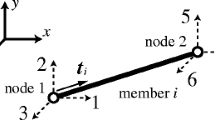Abstract
Geometrical optimization of trusses, i.e. optimization of the cross-sectional areas of the members and the coordinates of the joints, is solved by atwo-level approximation concept (TLAC). Displacements and element forces are approximated by first order Taylor series expansions in terms of generalized variables (or their reciprocal) which define the geometrical properties of the elements. This approximation leads to a high-qualityfirst level approximate problem (FA) which is solved by considering a sequence ofsecond level approximate problems (SA) in the design variable space. The method presented here represents a new approach to the solution of geometrical optimization problems. Numerical examples are given to demonstrate the high efficiency of the proposed method.
Similar content being viewed by others
References
Chan, A.S.L.; Kunar, A. 1974: A method for the configurational optimization of structures.Comp. Meth. Appl. Mech. Engng. 5, 865–880
Desai, C.S.; Abel, J.F. 1972:Introduction to the finite element method. New York: Von Norstrand Reinhold
Fleury, C.; Schmit, L.A. 1980: Dual method and approximate concept in structural synthesis.NASA CR-3226
Hansen, S.R.; Vanderplaats, G.N. 1988: An approximation method for configuration optimization of trusses.AIAA Paper No. 88-2432, AIAA/ASME/ASCE/AHS Structures, Structural Dynamics and Materials Conf. 1988
Imai, K.; Schmit, L.A. 1981: Configurational opimization of truss.J. Struct. Div. ASCE 107, 745–756
Kirsch, U. 1982: Synthesis of structural geometry using approximation concepts.Comput. Struct. 15, 305–314
Kirsch, U. 1989: On the relationships between optimal structural topologies and geometries. In: Brebbia, C.A.; Hernandez, S. (eds.)Computer aided optimum design of structures: recent advances. Berlin, Heidelberg, New York: Springer
Lipson, W.R.; Gwin, L.B. 1977: The complex method applied to optimal truss configuration.Comput. Struct. 7, 4169–4175
Svanberg, K. 1981: Optimization of geometry in truss design.Comp. Meth. Appl. Meth. Eng. 28, 63–80
Topping, B.H.V. 1983: Shape optimization of skeletal structures: a review.J. Struct. Div. ASCE 109, 1933–1951
Vanderplaats, G.N. 1975: Design of structures for optimum geometry.NASA TMX-62, 462
Vanderplaats, G.N. 1984: Numerical methods for shape optimization: an sssessment of the state of the art. In: Atrek, E.; Gallagher, R.H.; Ragsdell, K.M.; Zienkiewicz, O.C. (eds.)New directions in optimal structural design. Chichester: Wiley
Vanderplaats, G.N.; Moses, F. 1972: Automated design of trusses for optimum geometry.J. Struct. Div. ASCE 98, 671–690
Zhou, M.; Xia, R.W. 1989a: An efficient method of truss design for optimum geometry.Comp. Struct. (accepted)
Zhou, M.; Xia, R.W. 1989b: Two-level approximation concept in structural synthesis.Int. J. Num. Meth. Eng. (accepted)
Author information
Authors and Affiliations
Additional information
The method described in this paper was originally formulated by the author in the PR China
Rights and permissions
About this article
Cite this article
Zhou, M. Geometrical optimization of trusses by a two-level approximation concept. Structural Optimization 1, 235–240 (1989). https://doi.org/10.1007/BF01650953
Received:
Issue Date:
DOI: https://doi.org/10.1007/BF01650953




